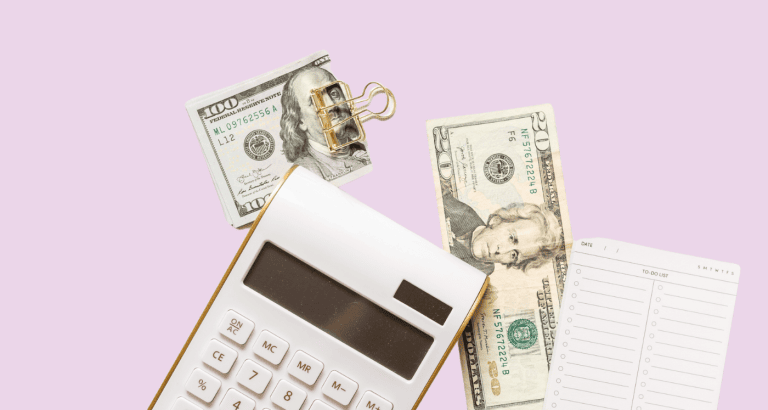How the 50/30/20 Budget Example Can Work for You
The 50/30/20 budget is one of the best ways to get on track with finances. Using this method will help you save a large amount of money, pay all your bills, and not feel too restricted on spending.
If you’re thinking about getting started with this form of budgeting, you might be wondering how it works. Is there a template to follow or an example?
I’m going to show you how a 50/30/20 budget example can work well for you. It’s perfect for many lifestyles and can make your financial processes easier.
What is the 50/30/20 Budget Strategy?
This strategy uses percentages of your income to create a budget. The idea is to take the amount you make each month – your take-home pay – and divide it into three categories.
As an affiliate partner of various brands and sponsored content, HerPaperRoute may earn commission on qualifying purchases. Disclaimer | Advertise With Us
Within those categories are more subcategories, but the three main ones are what matter most.
To start, you’ll take the first 50% of your take-home pay and use that to pay expenses. This includes bills, mortgages, groceries, gas, insurance, and anything you need to pay for each month.
You can also include things that you spend on a yearly or quarterly basis. You simply divide the amount by month instead.
Next, you’re left with 30% of your take-home pay. This is the amount you can spend however you like. You can, of course, have spending categories like eating out, travel, or shopping.
How you do that part is up to you, but stick to your 30%, and you can spend without guilt.
Last, of the remaining money, 20% will be used for savings. This means IRAs, workplace retirement plans, investments, and emergency funds.
You use 20% of your income for these things. If you’re paying off any debt, you will include that in this portion of the budget, as well.
How the 50/30/20 Budget Really Works
This 50/30/20 budget example seems good in theory, but how does it really work? What if you get paid biweekly? How do you account for extra cash that isn’t typically part of your budget?
What if your expenses cost more than 50% one month? A budget is only reasonable if it works, so let’s take a look at this one.
If your paychecks come every other week, it’s still easy to use this budgeting system. One solution is to divide your budget in half.
You still use the 50/30/20 budget example, but you do this twice a month instead of once. You can pay half your bills and have half your savings and spending money each pay period.
If you hate budgeting and can’t stand the thought of having to do this more than once a month, you can instead get a month ahead on everything.
Find out what your usual take-home pay is for a month, and work hard to save this amount as quickly as possible. That way, each month, you’ll use the money you already have, and you can save your current paychecks for the next month’s budget.
What if you get extra cash that you don’t usually count in your budget? First of all – yay! Second, think about where you should add this into your budget.
Since it isn’t part of your usual 50/30/20 budget example, you can add this cash to whatever category you see fit.
Your expenses should already be taken care of, but maybe you want to add a bit more to savings? Or spending on an upcoming trip or event?
If you know that you’ll receive bonuses throughout the year, try to plan extra things into your budget for the times when you know you’ll receive that extra cash.
Maybe the 50/30/20 budget works well most of the time, but you have a month or two where your expenses cost you a bit more than 50%. This is not a big deal, and there are a couple of ways to handle it.
First, check and see what is making your expenses higher. Did you add new subscriptions, or did your electric bill go way up?
Try to determine the cause and get back to an expense amount you’re comfortable with. If the higher bills are due to not accounting for annual or semi-annual expenses, like insurance, try to fix this in your budget by saving for these costs throughout the year.
Last, you can borrow from your saving and spending categories for the month. You probably won’t notice a 5% difference that much, but it can help you get through until the next paycheck.

Is the 50/30/20 Rule Good?
The answer to this isn’t immediately apparent. Whether or not you’ll like this method comes down to the amount you make, the cost of your expenses, and how well the budget works for your lifestyle.
Suppose you have low expenses or a high income. In that case, this rule will work well for you because low costs mean that you should be able to afford to keep them under 50% of your paycheck, even without a high income.
If you do make a large amount of money each month, then as long as your expenses aren’t incredibly high, you should be able to keep to this budget.
The 50/30/20 budget example may not work well for those with low incomes and/or high expenses. Because if your bills are expensive, it may be more than 50%. Same thing with income – you could have trouble with keeping to the percentages.
Overall, this budget is a good rule for most, so long as it fits with your income and expenses. It can be a great long-term strategy that helps you save and spend efficiently.
50/30/20 Budget Rule Pros and Cons
Every budget has pros and cons. You should consider a few things to help you decide if this budget is right for you.
Pros
- Simple. You can’t get much simpler than three budgeting categories – expenses, saving, and spending. And sometimes, with finances, simple is best.
Why make money more complicated than it needs to be, after all? If you’re new to budgeting, this can be a great approach because it doesn’t require too much effort. It also helps budgeters that are looking for a new way to do things.
- Better than no plan. While it may seem like it isn’t a perfect fit, the 50/30/20 budget example is better than just allowing your money to have free reign.
There are definitely ways to budget that could be better for your lifestyle. Still, it’s a great way to get started doing something with your money that’s consistent.
Cons
- Doesn’t work for everyone. No budget is perfect, and the 50/30/20 budget example doesn’t make sense for every person. Some people may find that 50% is too low for expenses or that they’d rather budget in a different way that aligns better with their values.
- 20% savings isn’t enough for some people. While 20% is a lot and will probably help you reach many retirement goals following a regular retirement schedule in your 60’s, some people have other plans.
If you want to retire early, 20% may not be enough, for example. Or, if you want to have a lot of money in retirement, you might want to increase your savings rate.
Is the 50/30/20 Rule the Best Way to Budget Your Money?
That depends. It’s an excellent start for some, but it isn’t so great for others.
If you want to save more because you plan on retiring early or with more money, the 50/30/20 budget example may not be best. It also doesn’t work if your expenses are more or less than 50%.
But for others, this budget is a great way to get started with healthy financial planning. It can make budgeting a breeze, and it definitely helps you to begin saving and spending correctly. You will have a chance to adjust the amounts and percentages later if you want to do so.
How to Set Up Categories with the 50/30/20 Budget Rule?
Here’s how to easily set up your 50/30/20 budget categories to make the process simple.
Needs
The 50% part of the budget focuses on your needs, as I mentioned earlier. But what are the specifics of this?
First of all, needs are things you can’t do without. This includes food ( basic groceries, not gourmet dinners out), transportation costs, bills, and other necessities. Things you need for survival.
Related: How Much Should You Be Budgeting For Food?
Wants
Wants are the things that make your budget fun. 30% is a pretty good amount to spend, too.
It should allow you to pay for coffee, subscription and streaming services, books, extra clothes, and anything else that you don’t need but would like to have.
If there’s something expensive that you’d love to buy but can’t afford, you can always save some of this money and add it to the next month in order to pay for things that take more cash, like vacations.
Savings
The 20% of the income you put towards savings includes your retirement savings, investments, rainy day, and emergency fund savings.
You may also have debt payoff in this category. 20% is a great starting place for savings, though you may wish to do more in the future.
50/30/20 Budget Template
Finally, the template that will help you make your budget without difficulty! Here are the basics.
Calculate Your Take-Home Pay
You want to know what amount you make after taxes. If you get paid once a month from one job, this will be really easy. If you are paid biweekly or have income from several sources, you may need to look back through your paychecks and add everything up. G
et the number you make in one month – this will be the starting point for your budget.
50% to Your Expenses
Your bills, expenses, and rent or mortgage costs should be paid for with 50% of your income for the month. Hopefully, this will work well with the amount you make.
If you find that 50% isn’t quite enough, you can adjust to 55% or 60%. If you are fortunate enough that 50% is too much for your expenses, try adding to your other categories, preferably savings.
You’ll need to add up your monthly expenses and get the total. Do this by using a calculator, and a pencil and paper if you like.
Then, add your take-home pay into the calculator and multiple by .50. This should give you whatever is 50% of your take-home pay, which should hopefully match your expense amount.
30% to Spending
Next, the 30% you’ll use for spending. The same tactic applies. Take your take-home pay amount and multiply by .30 to see the amount you can spend.
You can choose to keep this as a lump sum, or maybe you want to ration out your spending by dividing it into weeks. Whatever works better for you.
20% to Saving
Last, take your take-home pay and multiply it by .20 to get the amount to save. You can then divide this into various accounts.
You might save a percentage for retirement, a percentage for investments, and a percentage for emergencies.
The 50/30/20 Budgeting Example Can Work for You
The 50/30/20 budget example is pretty easy to get started with and stick to, especially if you use the calculator mentioned above to help. You can quickly assess where all of your money should go without it taking hours to figure out.
Because of this, the 50/30/20 budgeting example can work for most people. It is beneficial for getting on track financially if you aren’t used to a budget. Give the 50/30/20 budgeting example a try – and watch as you’re able to easily pay bills, spend well, and save a ton of money!
Related Articles:







![Advantages and Disadvantages of Budgeting [You Need To Know] 6 Advantages and Disadvantages of Budgeting [You Need To Know]](https://herpaperroute.com/wp-content/uploads/2021/11/Advantages-and-Disadvantages-of-Budgeting-768x410.png)




